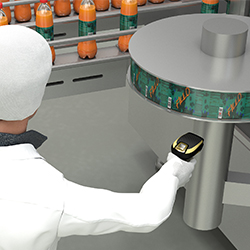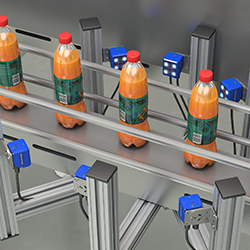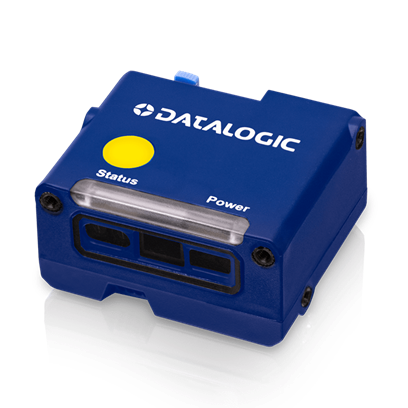Primary Packaging for Beverage & Food Solutions
Primary Packaging for Beverage & Food Solutions
In the dynamic world of food and beverage packaging, rules and regulations reign supreme. The industry faces unique challenges, requiring meticulous validation to ensure product safety and uphold quality standards, and meeting regulatory compliance. It is therefore paramount to maintain packaging-line efficiency while meeting these stringent requirements.
Gone are the days of costly mistakes and potential hazards caused by using the wrong packaging materials. Advanced technology provides foolproof validation systems, eliminating any confusion between materials that may have similar physical qualities but differ in logos, ingredients, languages, or instructions. Furthermore, inventory levels need to be accurately monitored and maintained, whilst ensuring that traceability of all products is never compromised, enhancing packaging-line efficiency like never before.
Say goodbye to faulty labels and costly reworks. Solutions that includes meticulous label verification process to ensure the presence and accuracy of labels on beverage lines before they reach retail shelves must be deployed. A foolproof system helps eliminate inefficiencies so that orders are fulfilled with ease, saving valuable time and resources.
Beverage & Food primary packaging includes verification of the incoming packaging material, as well as the ability to read and confirm the packaging contents by reading the relevant barcodes displayed on the labels or sleeves.
Regardless of product type, whether it is a can, bottle, or cardboard container, innovative technology must be deployed that effortlessly reads barcodes in any orientation, ensuring that line speeds run at high speeds without risk of affecting barcode scanning ability. A single scanner could easily be overwhelmed by random label orientation, and a multi-scanner solution providing a 360 degree view helps guarantee seamless operations and impeccable product integrity.
Beverage&Food companies require game-changing solutions to unlock unparalleled efficiency to their business to new heights.
PACKAGING MATERIAL VERIFICATION

Loading the proper consumable packaging materials into food and beverage packaging lines is a critical step in ensuring production accuracy and the safety of end consumers. Labels, wrapping film, and lidding foil are costly materials that, if not appropriately verified, can result in expensive reworks, line downtime, and unnecessary waste generation.
Consumable packaging material verification before loading into production is efficiently performed by scanners like the Datalogic PowerScan 9600 industrial handheld reader series.
Unlike many other industries, food and beverage packaging is often subjected to stringent rules and regulations. Packaging materials require validation to ensure product safety is not compromised and the material is fit for its intended purpose. This scrutiny must be done repeatedly, consistently, and without compromising packaging-line efficiency.
Costly, and potentially dangerous, mistakes occur when wrapping film, lidding foil, cartons, and other packaging materials, which may have similar physical qualities, but different logos, ingredients, languages, or instructions, are inadvertently used. In an environment where a wide range of products may be running through the same manufacturing facility, keeping inventory updated in the enterprise resource planning (ERP) system, confirming materials, and ensuring traceability are essential for packaging-line efficiency.
Verification of materials, like that required for the food and beverage industry, can be automated using an industrial handheld reader like the Datalogic PowerScan 9600. The device, designed specifically for demanding production environments, is equipped with an auto-range reader that efficiently and accurately captures barcodes, facilitating on-site data entry. The scanner's superior reading performance easily processes various label types and print quality from multiple suppliers. Complementing the performance of the scanner is Datalogic's green spot "good-read" visual feedback.
The PowerScan 9600 works in both wireless and tethered configurations for maximum flexibility in the production environment. The unit is built to IP65 and IP67 standards and is rated to withstand 50 2.5-meter drops onto hard concrete. The rugged industrial barcode reader is built for long-lasting durability with a trigger that has been tested to resist up to 10 million hits. Smart battery technology that's hot-swap capable and wireless charging maximize charging efficiency and battery life, ensuring the scanner is always ready to go.
BARCODE-DRIVEN LABEL/SLEEVE VERIFICATION

Automatic label or sleeve barcode reading immediately after application verifies presence and correct label application on bottles, cans, and jars.
The highly compact Datalogic Matrix 120 stationary 2D imager plays a crucial role in identifying and recording a product label, increasing production efficiency and positively impacting enterprise development. The ultra-compact Matrix 120 is easily installed in labeling or sleeving machines with the most constrained spaces, ensuring in-line verification. A complete label check on every filled container grants fault-free labeling operations.
One of the final steps in the labeling process for beverage lines is to confirm the presence of the labels and that they contain accurate information. Shrink-sleeving and other label applications must be verified before containers can be placed on shelves in retail outlets. Faulty, incorrectly labeled products lead to costly reworks and inefficiency in fulfillment.
A complete online labeling verification system is required to ensure the proper label is applied in the appropriate position. The best designs are automated and unattended, eliminating errors attributable to human intervention. Datalogic's Matrix 120 ultra-compact industrial 2D imager provides this solution.
The Matrix 120 is easily integrated as an OEM component into a manufacturer's label reading and verification systems, or it can be retrofitted to work with existing installations. The unit's compact size provides flexibility of use and enables it to fit and function in constrained spaces and accurately read through the narrowest openings.
Variability in labeling materials poses no problem for the Matrix 120. Transparent plastic film, low-quality printing, and difficult-to-read barcodes are all read without error. On-board error and fault detection further guarantee perfect labeling.
As a stationary industrial scanner (SIS), the Matrix 120 is built to ensure that bottling and canning lines are free from costly reworks and unnecessary waste. Boasting the highest industrial grade in its class, the unit is certified to IP65 standards. It uses glass-free protective windows for the food and beverage environment, which improves quality and reliability. The scanner also includes DL.CODE configuration software, embedded Ethernet connectivity, X-press buttons, and an intuitive man-machine interface make it simple and easy to operate. Multiple models of the Matrix 120 2D imager allow it to cover an extensive range of applications in the food and beverage industry.
360° LABEL BARCODE READING

As they leave the labeler, containers are whisked along a conveyor belt to final packaging. Along the route, friction on the conveyor's side rails causes rotational forces to take over, leaving no two containers with their associated barcoded labels oriented in the same direction. Reading these nonuniformly oriented labels on fast-moving cylindrical containers is a challenging task.
The solution is a circular array of connected Datalogic Matrix 220 imagers synchronized by Datalogic proprietary ID-Net protocol performing dynamic omnidirectional label barcode reading on beverage containers.
Spinning and jostling along the labeling line, no two containers are oriented in the same direction. Regardless of container type, be it pop cans, dressing bottles, or cardboard ice cream tubs, the semi-chaotic positioning is just the nature of the process. But, random label orientation makes reading the barcodes on those packages for presence, traceability, and quality assurance an impossible task for a single scanner. There is, however, a solution.
A circular array of connected Datalogic Matrix 220 imagers synchronized by Datalogic's proprietary ID-Net protocol ensures a 360° reading of barcodes regardless of package orientation on the line. The circular array of readers covers the entire container circumference (360°) with overlapping fields of view (FOVs), so optimal dynamic reading is possible with all barcode orientation on the label . The overlapping FOVs also provide redundancy by ensuring that barcodes in boundary positioning between two readers are effectively captured.
Other variables, like container shape, code positioning (picket fence or step ladder orientation), linear or 2D symbology, or codes printed against low contrast backgrounds will not impede the imager array. The solution is designed for superior performance, thanks to a high-resolution sensor, a new image multicore processing platform, and innovative lighting options. An industrial-grade high dynamic range (HDR) feature delivers unsurpassed image quality and contrast facilitating code reading with faster line speeds.
At the heart of the solution, the Matrix 220 imagers are built to IP65 and IP67 industrial standards, guaranteeing the highest quality and robustness for food and beverage applications. The unit leads the market with the automatic setup mode for quick and easy code reading.
TRACKING OF FOOD PRIMARY PACKAGING
![]()
Tracking items in automated food packaging lines requires superior barcode reading performance. The challenges to getting a "good read" are extensive. Varying packaging materials, code symbology, code resolution, and nonuniform package sizes all present hurdles. Barcodes printed in an assortment of colors against backgrounds of varying hues and shades multiply the pitfalls.
The Datalogic Matrix 120 stationary industrial scanner successfully addresses this complex and challenging scenario. Moreover, the unit's compact dimensions allow for easy integration in the limited space available inside packaging machines.
Bags, blister packs, boxes, and cartons are some package types that pass along automated food packaging lines. At varying speeds along rollers, belts, and screws, packages of food and beverages trundle along en route to larger containers for shipping downstream in the supply chain. Tracking each item is essential for traceability, safety, and inventory purposes. Primary packaging barcodes facilitate this, but tracking items in an automatic food packaging line requires superior barcode-reading performance. The Datalogic Matrix 120 stationary industrial scanner successfully addresses this complex and challenging scenario.
The challenges to getting a good barcode read are extensive. Inkjet, laser, and preprinted flexographic are printing technologies that each have benefits and shortcomings in supporting reliable barcode reads. Crinkled packages, labels applied askew, ambient lighting, packaging material, and an endless palette of barcode and background colors all compound the complexity of the task. The array of machine-readable symbols that store identifying data about the food or beverage with which they are associated is an additional variable; linear barcodes, 2-D matrix codes, and stacked linear codes can all be found on food and beverage packages. The Matrix 120 imager tackles each of these and leads the market for ease of use.
An online real-time detection system using a Matrix 120 plays a crucial part in identifying and recording a product label, increasing production efficiency, and positively impacting traceability. The imager is unstopped by irregular shapes and deforming geometries and quickly reads in either static, indexing, or continuous motion environments.
The Matrix 120 is the smallest ultra-compact industrial 2D imager on the market today. Suitable for product traceability and information sorting, it readily embeds into the limited space inside packaging machines. Beyond its compact size, the unit also features an embedded Ethernet interface, the highest industrial-grade components, DL.CODE configuration software, X-Press buttons, and an intuitive human-machine interface.
Products and Solutions
Video Gallery
Matrix 220 XAI | Ultimate DPM with the fastest auto-setup ever,...
Datalogic Matrix Family | Speed meets flexibility
Reasons to be Cheerful, from Datalogic | PowerScan™ 9600 Series






